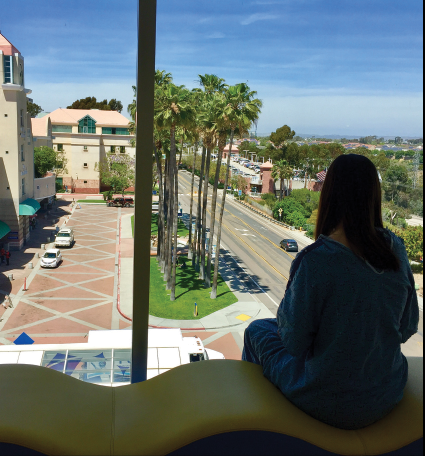
Five years ago, our 13-year-old daughter, Haley, was transported by ambulance after experiencing severe abdominal pain for over a month.
She was transported for what the medical technicians believed was a ruptured appendix to Rady Children’s Hospital, in San Diego, California. Shortly before surgery, doctors found that it was not the appendix but something much more life-altering. Tests later showed that she had a large abscess attached to her intestines and was diagnosed with a stage-5+ severe autoimmune disease.
After several months in the hospital, and major surgery to remove a large portion of her intestines, the doctors finally felt they had her disease under control, with the assistance of regular injections, changes to her diet and daily oral medication.
When Haley was diagnosed, going on the road full-time was merely a dream for us, because after her surgery we were unsure about the future. Concerned about her wellbeing and recovery, we side-lined our dream of going on the road full-time. We continued doing short “vacation” trips in the RV for almost a year, and all three of us still felt the undeniable tug and call to hit the road.
Many times, when people experience an illness, a tragedy or any other significant change in life, it can evoke two different emotions or directions. The experience can either break your spirit, leading to sadness and fear of the future, or it opens your eyes to what is really important in life. With our family, our experience created a “carpe diem” (or seize the day) mentality. If we could manage her illness at home, why couldn’t we manage it on the road? Life is precious and short, and we weren’t about to waste another minute of it sitting at home.
A Plan for Traveling with Chronic Illness
Prior to going on the road full-time, we wanted to have a plan in place for Haley.
We enrolled her in a rigorous online high school program to help meet her academic needs, and we scheduled multiple meetings with her team of doctors, explaining what we wanted to do. Her specialists were supportive of our decision and were especially thrilled that Haley was excited about the change since a large portion of attaining remission would be avoiding stress.
With the medical staff on board, they began to lay out a care management schedule that would allow us to travel throughout the United States. This involved having all routine maintenance tests completed before leaving the area. Haley also requires regular blood work. Fortunately, we are able to have the tests done at various labs across the country that report back to her doctor in California.
We set up a home-care delivery service with CVS specialty pharmacy to allow her injection medicine to be delivered to any CVS across the nation for pick up, or any address of our choosing. We also worked with our insurance provider to allow her to receive three-month shipments that buy us time between prescription refills. We have been able to receive her medication in RV parks in Texas from CVS pharmacies in Las Vegas and Mississippi and even at friends’ houses along the way.
The Children’s Hospital network allows for an online patient portal where I can communicate with her doctors immediately should problems or questions arise. I’ve also made a habit of researching and locating the closest Children’s Hospital when arriving in a new town.
We set up annual checkups, procedures and testing to be done at her home-base hospital in San Diego, and that allows us to plan ahead of time (a year in advance) to accommodate scheduling and travel dates.
On The Road with a Chronic Illness
We sold everything, hit the road and felt confident that we had all of our ducks in a row and that we were prepared for anything. One year later, our confidence was tested when Haley once again had severe complications.
We were camping at the Valley of Fire State Park, in Nevada, with no cell service, and felt disconnected from her doctors and in unfamiliar territory. She had been doing well for so long. Now, what to do?
I drove out of the park multiple times a day, checked messages and communicated with Haley’s doctor back in California through the online patient portal. Concerned, the doctor advised us to get on the next flight out and admit her to her home hospital in San Diego.
As RVers, we don’t move quickly. We are like turtles, with our house on our back, and, in general, we can’t (and don’t) move down the road fast. Slow and steady wins the race for us, but, in this case, time was of the essence.
Luckily, we were near the major international hub of Las Vegas and able to schedule a flight out the next day for a reasonable price and considerably cheaper than paying for gas for the almost 800-mile round-trip with the RV.
I called ahead, and the doctor preplanned to have a room ready for us. We had family waiting to pick us up from the airport, take us to hospital, and we walked right into her room on the fourth floor.
She was admitted immediately and could receive the care she needed right away because her chart and history were waiting for us, along with the doctor’s orders and her specialists.
Healing and The Future

After two back-to-back emergency flights to San Diego within the last two months, Haley (now 16) is on new medication and is on the road to recovery and remission.
Living together in 300 square feet is not for everyone, and each family dynamic is different. For us, living on the road is a dream come true. For our family, we were already close before we hit the road, but the experiences we’ve shared have created bonds that are unbreakable.
We’ve worked disaster relief in the South; met new friends in every state; helped set up a drug, alcohol and human trafficking home in the Southwest; pet and fed deer in Texas: explored caves and spent a lot of time immersing ourselves in new towns and learning things we never knew about our own country. We never know where we are headed next, and we like it that way!
Traveling With Medical Needs

People ask, “How can you travel with her disease?” Most people feel that having medical needs automatically prevents full-time RV travel. Our philosophy is that it doesn’t have to. It adds another piece to the “adventure puzzle.” It does require pre-planning and thinking ahead, but it’s worth it.
Haley has a diagnosis that she must live with the rest of her life. It is part of all of our lives, but we don’t let it rule or dictate our lives.
She is free to explore, see the country and live her life fully without being bound or held back by her disease. She can have complications anywhere, but, if we have a plan in place, good communication and options. We will continue our RV adventures and raising our daughter to be responsible; aware of her illness, but never enslaved to it.
Author
Jena Jones
Jena enjoys the full time RV lifestyle with her husband Glyn, Haley (now 16) and their cat, Jo-C. As a “planner,” she loves the freedom that comes with living and traveling in an RV. Jena enjoys assisting in disaster relief volunteer projects with her family and she is always seeking sunshine and warm weather.
You can share the Joneses adventures online at totally-trailer.com
Was this post helpful? Pin it to Pinterest!












2 Responses
I’ve been fulltime for close to 3-1/2 years; two years ago my wife was diagnosed with metastatic breast cancer and a year ago I was diagnosed with multiple myeloma. My wife lost her battle with cancer in May and I’m still receiving cancer treatment, but with a good prognosis. Being fulltime allowed us to locate ourselves near the Mayo Clinic for treatment and our coach is a right-sized home for ease of living. Although distant ongoing travel is on hold for a while I’m still able to get in some short get-away trips. There will be challenges going forward but I’m still inspired to keep that dream alive. As Joseph Campbell said: “We must let go of the life we have planned, so as to accept the one that is waiting for us.”
We have been full timing since 2007. In 2001 I was diagnosed with multiple sclerosis and was born with an immune deficiency along with a few other comorbidities that I have to manage. My MS plateaued about 10 years ago. My immune system crashes periodically but I have been able to get by infusing SCIG. I have been infusing SCIG (Hizentra) every week. So far so good. We are using the physicians in Reno. I was referred to an immunologist and a nasologist in Reno.
Because coronavirus represents a risk to those of us who have an immune deficiency we avoid places like Las Vegas. Just too many people flying in from every corner of the globe.
AS with most CVID patients, I had a problem with chronic sinusitis but met an ENT in Reno who specializes in treating CVID patients. I have been antibiotic free for 9 months now and have been able to worry less about my MS. From what I can gather Haley has to manage something akin to an immune deficiency. Let her know that we live in a 29′ 1976 Airstream. It is tight but we try to spend as much time as we can outside.
The IG distributor I have been working with have allowed us to wander aimlessly around the US and Canada and we have traveled to Europe several times. In 2016 we took 5 months to drive to and from Kenai, AK. We just go slow and build in time for me to find a place to infuse and take advantage of the wilderness around us.